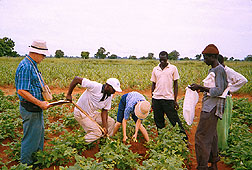Diagnosing Yield Barriers in West Africa
In the Cinzana region of Mali, West Africa, farm families live in villages surrounded by their land. Farming is still nonmechanized. Animals help till the soil, and manure is the main source of fertilizer.
An Agricultural Research Service scientist recently traveled to West Africa's Sahelian region to learn more about the farming methods and share his insights on increasing food production.
Plant physiologist Dan Israel, who is in the ARS Soybean and Nitrogen Fixation Unit at Raleigh, North Carolina, says he enjoyed visiting farmer Saouti Toure near the Cinzana Research Station and seeing research being done on his farm in cooperation with a Malian scientist.
"Rock phosphate mined in Mali was being composted with manure to make the phosphorus more available to millet and sorghum crops when applied to the soil," he says. "Test plots on Toure's farm showed this composted mixture increased plant growth as compared to unfertilized plots."
Improved soil fertility can help crop production, which not only feeds farm families, but also lets growers sell food to nearby villages and larger cities such as Bamako and Segou.
Israel's visit was part of a multi-institutional program of the U.S. Agency for International Development. The 5-year, $5 million project will evaluate soil management and productivity in many countries.
"The goal of this particular project is to develop computer software using data from years of soil fertility and plant nutrition research," says project leader Jot Smyth, who is with North Carolina State University. "We want to design it so Malian extension agents and farmers can diagnose barriers to crop yields."
Israel's area of expertise is soybean production. In particular, he studies how nodules on soybeans convert nitrogen from the air to a form that the plants can use for growth in the process of nitrogen fixation.
Cowpeas, the principal protein-source crop in the Cinzana region, also fix nitrogen in this way. During his visit, Israel evaluated the effect of phosphorus deficiency and soil acidity on nodule health. A pink to reddish-brown nodule interior means good nitrogen fixation, for example.
"The fields in Mali could yield more with extra fertilizer, but water availability will set the limit on how much yield improvement can be realized from the fertilizer," says Israel. "We want to develop a software program adaptable to a range of environments and yield potentials."
In the final stages of this project, sociologist Frank Smith, who is with North Carolina State, will evaluate its impact by surveying Cinzana extension agents and farmers about what they found most useful about the software program.—By Jill Lee, Agricultural Research Service Information Staff.
This research is part of Improving Plant Biological and Molecular Processes, an ARS National Program described on the World Wide Web at http://www.nps.ars.usda.gov/programs/cppvs.htm.
Daniel W. Israel is in the USDA-ARS Soybean and Nitrogen Fixation Research Unit, 4114 Williams Hall, North Carolina State University, Raleigh, NC 27695-7620; phone (919) 513-3031, fax (919) 515-2167.
"Diagnosing Yield Barriers in West Africa" was published in the June 1999 issue of Agricultural Research magazine.







